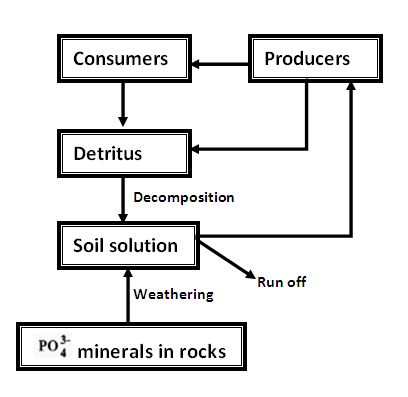
Answer
446.1k+ views
Hint:The phosphorus cycle is one of the biogeochemical cycles that help to describe the movement of the phosphorus through the lithosphere, hydrosphere, and also the biosphere. As of many other biogeochemical cycles, the atmosphere does not play a significant role in the movement of the phosphorus, because the phosphorus and the phosphorus-based compounds are usually solids at the typical ranges of the temperature and the pressure found on Earth.
Complete answer:The given chart represents phosphorus cycling in the ecosystem. Because the phosphorus cycle is a sedimentary cycle, it has the lithosphere as its reservoir pool. The minute amount of the rocks dissolves in the soil solution when they are weathered. The natural reservoir of the phosphorus is the rock which is present in the form of calcium phosphate and can also be found in the insoluble ferric form. These inorganic phosphates are mainly absorbed by the plants from the soil and water bodies. And then eventually they pass into the animals through the food chains. There is no respiratory release of the phosphorus.
Therefore, the correct answer is option B).
Additional Information:
Phosphorus is an essential nutrient for plants as well as for animals. It is a part of the DNA-molecules which are the molecules that store energy and fats of the cell membranes. The phosphorus is also a building block of certain parts of the human and animal body, such as the bones and the teeth. The phosphorus cycle is a biogeochemical cycle that deals with the movement of the phosphorus in the form of different compounds through the various systems of Earth-like the biosphere, hydrosphere, and lithosphere.
Note:The phosphorus cycles through the plants and animals much faster than it does through the rocks and sediments. When the animals and plants die, the phosphates will return to the soils or oceans again during the process of decay. After that, the phosphorus will end up in sediments or the rock formations again and will remain there for millions of years.
Complete answer:The given chart represents phosphorus cycling in the ecosystem. Because the phosphorus cycle is a sedimentary cycle, it has the lithosphere as its reservoir pool. The minute amount of the rocks dissolves in the soil solution when they are weathered. The natural reservoir of the phosphorus is the rock which is present in the form of calcium phosphate and can also be found in the insoluble ferric form. These inorganic phosphates are mainly absorbed by the plants from the soil and water bodies. And then eventually they pass into the animals through the food chains. There is no respiratory release of the phosphorus.
Therefore, the correct answer is option B).
Additional Information:
Phosphorus is an essential nutrient for plants as well as for animals. It is a part of the DNA-molecules which are the molecules that store energy and fats of the cell membranes. The phosphorus is also a building block of certain parts of the human and animal body, such as the bones and the teeth. The phosphorus cycle is a biogeochemical cycle that deals with the movement of the phosphorus in the form of different compounds through the various systems of Earth-like the biosphere, hydrosphere, and lithosphere.
Note:The phosphorus cycles through the plants and animals much faster than it does through the rocks and sediments. When the animals and plants die, the phosphates will return to the soils or oceans again during the process of decay. After that, the phosphorus will end up in sediments or the rock formations again and will remain there for millions of years.
Recently Updated Pages
Master Class 10 Science: Engaging Questions & Answers for Success

Master Class 10 Maths: Engaging Questions & Answers for Success

Master Class 10 General Knowledge: Engaging Questions & Answers for Success

Master Class 10 Social Science: Engaging Questions & Answers for Success

Master Class 10 English: Engaging Questions & Answers for Success

Master Class 10 Computer Science: Engaging Questions & Answers for Success

Trending doubts
Who was the founder of Anushilan Samiti A Satish Chandra class 10 social science CBSE

A particle executes SHM with time period T and amplitude class 10 physics CBSE

10 examples of evaporation in daily life with explanations

What is the full form of POSCO class 10 social science CBSE

Discuss why the colonial government in India brought class 10 social science CBSE

On the outline map of India mark the following appropriately class 10 social science. CBSE





